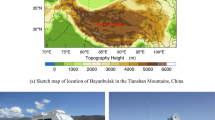Abstract
An artificial cloud seeding experiment was performed over the Japan Sea in winter to show how massive seeding could be effective to mitigate heavy snowfall damage. The results showed that 20 min after cloud seeding, a portion of the radar echo beneath the seeding track was weakened to divide the radar echo into two parts. In order to analyze the results, a numerical simulation was conducted by using the Weather Research and Forecasting model verion 3.5.1. In this simulation, the seeding effects were represented as phenomena capable of changing rain particles by accreting cloud ice and snow to form graupel particles and by changing cloud liquid water to snow particles. The graupel particles fell rapidly, thus temporarily intensifying the rainfall, which subsequently decreased. Therefore, the weakened radar echo in the field experiment is deemed to have been caused by the increase in rapidly falling graupel particles.
Similar content being viewed by others
References
Alberta Research Council, 1986: Research and operations 1980–1985: Weather modification in Alberta. Summary report and recommendations.
Byers, H. R., 1965: Elements of Cloud Physics. The University of Chicago Press, 191 pp.
Ćurić, M., D. Janc, and V. Vućković, 2007: Cloud seeding impact on precipitation as revealed by cloudresolving mesoscale model. Meteor. Atmos. Phys., 95, 179–193.
Guo, X. L., G. G. Zheng, and D. Z. Jin, 2006: A numerical comparison study of cloud seeding by silver iodide and liquid carbon dioxide. Atmos. Res., 79, 183–226.
Guo Xueliang, Fu Danhong, Li Xingyu, et al., 2015: Advances in cloud physics and weather modification in China. Adv. Atmos. Sci., 32, 230–249.
Hashino, T., and G. J. Tripoli, 2007: The spectral ice habit prediction system (SHIPS). Part I: Model description and simulation of the vapor deposition process. J. Atmos. Sci., 64, 2210–2237.
Hobbs, P. V., and M. K. Politovich, 1980: The structures of summer convective clouds in eastern Montana. II: Effects of artificial seeding. J. Appl. Meteor., 19, 664–675.
Holroyd, E. W., and J. E. Jiusto, 1971: Snowfall from a heavily seeded cloud. J. Appl. Meteor., 10, 266–269.
Ikawa, M., H. Mizuno, T. Matsuo, et al., 1991: Numerical modeling of the convective snow cloud over the sea of Japan. Precipitation mechanism and sensitivity to ice crystal nucleation rates. J. Meteor. Soc. Japan, 69, 641–667.
Kova·cević, N., and M. ćurić, 2014: Sensitivity study of the influence of cloud droplet concentration on hail suppression effectiveness. Meteor. Atmos. Phys., 123, 195–207.
Marwitz, J. D., and R. E. Stewart, 1981: Some seeding signatures in Sierra storms. J. Appl. Meteor., 20, 1129–1144.
Milivoj, B. G., S. B. Marković, M. Zorn, et al., 2013: Is hail suppression useful in Serbia?—General review and new results. Acta Geographica Slovenica, 53, 165–179.
Miller, J. R., Jr., E. I. Boyd, R. A. Schleusener, et al., 1975: Hail suppression data from western North Dakota, 1969–1972. J. Appl. Meteor., 14, 755–762.
Mlawer, E. J., S. J. Taubman, P. D. Brown, et al., 1997: Radiative transfer for inhomogeneous atmospheres: RRTM, a validated correlated-k model for the longwave. J. Geophys. Res., 102, 16663–16682.
Rosenfeld, D., and W. L. Woodley, 1989: Effects of cloud seeding in West Texas. J. Appl. Meteor., 28, 1050–1080.
Seto, J., K. Tomine, K. Wakimizu, et al., 2011: Artificial cloud seeding using liquid carbon dioxide: Comparisons of experimental data and numerical analyses. J. Appl. Meteor., 50, 1417–1431.
Thompson, G., P. R. Field, R. M. Rasmussen, et al., 2008: Explicit forecasts of winter precipitation using an improved bulk microphysics scheme. Part II: Implementation of a new snow parameterization. Mon. Wea. Rev., 136, 5095–5115.
Tomine, K., S. Masaki, W. Kenji, et al., 2015: An example of canal formation in a thick cloud induced by massive seeding using liquid carbon dioxide. J. Meteor. Res., 29, 682–690.
Woodley, W. L., J. Jordan, A. Barnston, et al., 1982: Rainfall results of the Florida area cumulus experiment, 1970–76. J. Appl. Meteor., 21, 139–164.
Xue, L. L., A. Hashimoto, M. Murakami, et al., 2013: Implementation of a silver iodide cloud-seeding parameterization in WRF. Part I: Model description and idealized 2D sensitivity tests. J. Appl. Meteor., 52, 1433–1457.
Author information
Authors and Affiliations
Corresponding author
Rights and permissions
About this article
Cite this article
Masaki, S., Kikuro, T. & Koji, N. Model analysis of radar echo split observed in an artificial cloud seeding experiment. J Meteorol Res 30, 386–400 (2016). https://doi.org/10.1007/s13351-016-5053-y
Received:
Accepted:
Published:
Issue Date:
DOI: https://doi.org/10.1007/s13351-016-5053-y



